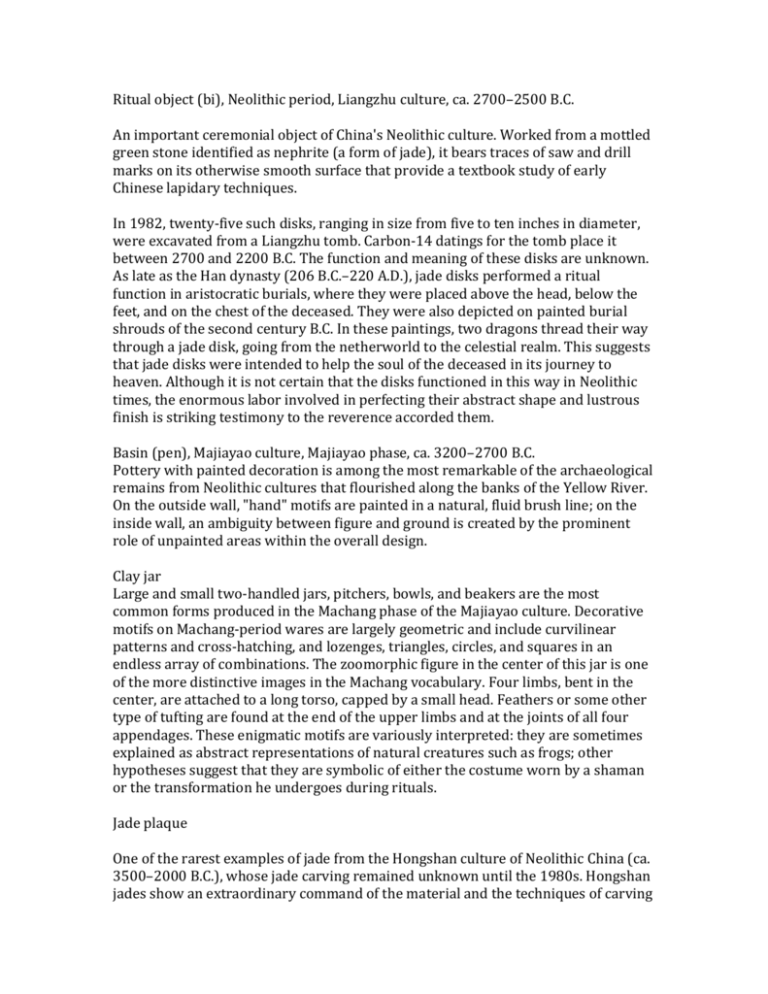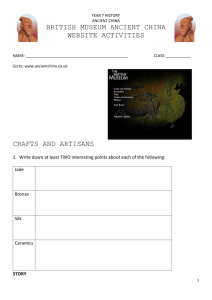text for china presentation
advertisement

Ritual object (bi), Neolithic period, Liangzhu culture, ca. 2700–2500 B.C. An important ceremonial object of China's Neolithic culture. Worked from a mottled green stone identified as nephrite (a form of jade), it bears traces of saw and drill marks on its otherwise smooth surface that provide a textbook study of early Chinese lapidary techniques. In 1982, twenty-five such disks, ranging in size from five to ten inches in diameter, were excavated from a Liangzhu tomb. Carbon-14 datings for the tomb place it between 2700 and 2200 B.C. The function and meaning of these disks are unknown. As late as the Han dynasty (206 B.C.–220 A.D.), jade disks performed a ritual function in aristocratic burials, where they were placed above the head, below the feet, and on the chest of the deceased. They were also depicted on painted burial shrouds of the second century B.C. In these paintings, two dragons thread their way through a jade disk, going from the netherworld to the celestial realm. This suggests that jade disks were intended to help the soul of the deceased in its journey to heaven. Although it is not certain that the disks functioned in this way in Neolithic times, the enormous labor involved in perfecting their abstract shape and lustrous finish is striking testimony to the reverence accorded them. Basin (pen), Majiayao culture, Majiayao phase, ca. 3200–2700 B.C. Pottery with painted decoration is among the most remarkable of the archaeological remains from Neolithic cultures that flourished along the banks of the Yellow River. On the outside wall, "hand" motifs are painted in a natural, fluid brush line; on the inside wall, an ambiguity between figure and ground is created by the prominent role of unpainted areas within the overall design. Clay jar Large and small two-handled jars, pitchers, bowls, and beakers are the most common forms produced in the Machang phase of the Majiayao culture. Decorative motifs on Machang-period wares are largely geometric and include curvilinear patterns and cross-hatching, and lozenges, triangles, circles, and squares in an endless array of combinations. The zoomorphic figure in the center of this jar is one of the more distinctive images in the Machang vocabulary. Four limbs, bent in the center, are attached to a long torso, capped by a small head. Feathers or some other type of tufting are found at the end of the upper limbs and at the joints of all four appendages. These enigmatic motifs are variously interpreted: they are sometimes explained as abstract representations of natural creatures such as frogs; other hypotheses suggest that they are symbolic of either the costume worn by a shaman or the transformation he undergoes during rituals. Jade plaque One of the rarest examples of jade from the Hongshan culture of Neolithic China (ca. 3500–2000 B.C.), whose jade carving remained unknown until the 1980s. Hongshan jades show an extraordinary command of the material and the techniques of carving it. They are characterized by their intriguing shapes, great attention to detail, phenomenal subtlety of surface, and engaging tactile quality, all of which are well demonstrated in the elegant form, fluent lines, subtle luster, and smoothly modulated grooves of this plaque. Large ceremonial structures built with rocks and graves lined with stone slabs have been excavated at Hongshan sites in northeastern China. Jade seems to have played a particular role in the culture; most, and often the only, artifacts found in Hongshan burials are jade. Many Hongshan jades are ornaments of some kind: they are either bracelets or pendants or they have fixings or holes that would allow them to be attached to the body or to clothing. But the exact function of several other types, this plaque among them, remains a mystery. ______________________________________________________________________________ Wine vessel Loosely based on the image of a bird, as can be seen from the hooked beak and glaring eyes at its front, this rare example of a ritual vessel known as a guang was used to pour wine or other potent beverages in ceremonies linking the rulers of the Shang dynasty (ca. 1600– 1050 B.C.) with their ancestors and supernatural forces. The metamorphic imagery that defines this vessel typifies bronzes cast at the late Shang: the coiled serpents emerging from the wings are accompanied by roaring tiger-dragons prowling along the sides; the horned bird that serves as a handle miraculously becomes a short-tailed dragon-serpent. All of these details, carefully cast in high relief, are set against a low-relief background of linked spirals known as thundercloud motifs. This container was cast using several ceramic piece molds, a method that had no parallel in the ancient world. In this technique, ceramic molds carved with complicated multilayered designs were assembled around an interior clay core. Molten bronze was then poured into the space left between the mold and the core. After the bronze had cooled and hardened, the ceramic molds were broken to reveal the vessels. Time and precision were required to make bronze vessels in this fashion, and the control of the raw materials, labor, and technology needed to make such objects was one of the prerogatives of the ruling elite during the Shang dynasty. Jade buffalo, late shang Objects made of jade are thought to have played a ceremonial role in many Late Neolithic cultures. Harder than steel, jade (or nephrite) is laboriously fashioned by means of slow abrasion with sand or quartz grit. During the Shang dynasty, artisans had full command of the artistic and technical language developed in the diverse Late Neolithic cultures that had jade-working traditions. While many Shang forms have their origins in earlier works, the carving of three-dimensional animals, used as charms or decoration, is an innovation that may derive from the interest in natural forms found in the bronze art of the period. Compact yet powerful, at rest yet alert, this buffalo illustrates the sophisticated jade working of the period in the careful depiction of its bulk and presence and the skillful handling of the stone's natural textures and colors. ___________________________________________________________________________________ Pendant in the form of a knotted dragon, Eastern Zhou dynasty (770–256 B.C.), 3rd century A conceptual as well as a technical tour de force, this pendant defies the obdurate character of jade and makes it appear to be impossibly supple and pliant. The pendant takes the form of a serpentine dragon, whose body is grooved to resemble twisted rope. The two ends of the dragon overlap to form a circular ring. One end has a flattened felinelike head with gaping jaws, bared fangs, and striations marking the eyebrow and upper lip. The other end loops behind the head and doubles back in an elegant counter curve. At the bottom of the ring, the sculptor further defies the nature of the medium by making the body appear to have tied itself in a double knot. The pendant was suspended from a small horizontal perforation drilled through the neck of the dragon at the apex of the ring, just behind the juncture of the two ends. Female Dancer, Western Han dynasty This figure is a quintessential example of early Chinese sculpture, which found its highest expression in the third to first centuries B.C. Unlike the geometric approach of the Greeks, the Chinese sculptors sought to capture the "life spirit" of the human subject, concentrating on facial expression and a posture that suggests movement— in this instance, a moment in a dance. Ritual food container (dui), Eastern Zhou dynasty Three small animals cast in the round embellish the dome-shaped lid of this bronze dui, or ritual food container. The animals also function as feet when the lid is inverted to serve as a tray. The surface of the vessel, a round bowl supported on a ring foot, is elaborately decorated with paired dragons and rolling curls. The composition of bone black and lacquer that fills the cast depressions of the design enhances the interplay between figure and ground. The sumptuous decoration was a major innovation in China's bronze tradition during the late Eastern Zhou dynasty, when Chinese craftsmen, inspired by the nomadic art of the steppes, added rich, colorful, and sophisticated designs to the surfaces of otherwise austere bronzes. By then, the function of bronze vessels had also changed, and they were seen more as symbols of wealth and status than simply as paraphernalia for solemn rituals. Each of these has own slide: Maitreya Buddha This sculpture, which is the largest early gilt bronze statue known from China, remains one of the best examples of the use of a distinctive style of drapery in Chinese art from about 460 to 490. The Buddha stands with his feet on an upturned lotus base set above a two-tiered pedestal. He has wide shoulders, a defined waist, and long legs and arms, and wears three garments: a long sarong-like undergarment, an intermediary piece, and a large rectangular shawl that is draped across the back and front and falls over his proper left shoulder. The folds of the shawl, which are shown as appliqué-like bands with a thin crease in the center, are distinctively patterned: they fall in inverted, interconnected lunettes over the chest and abdomen, and as vertical pleats along the sides of the torso. Those covering the shoulders and upper arms end in unusual flame-like forms. The rendering of the Buddha's physique derives from Indian traditions; however, the dramatically stylized patterns seen in the drapery can be traced to the art of Pakistan, and to related traditions at centers such as Kucha on the northern branch of the Silk Road. Maitreya is one of the more interesting deities in Buddhism. He is worshipped both as a bodhisattva (someone on the path to enlightenment) in this world and as a Buddha. Once our cosmic era has destroyed itself, he will be reborn as the teaching Buddha of the next great period. The identification of this sculpture as a representation of the Buddha Maitreya is based on a large dedicatory inscription at the back of the base, which also gives the date 486 Central watchtower The most important manifestation of Han imperial order was architecture: vast palatial complexes, towered gateways, and city walls were built as symbols of power and prestige as well as for defense. This glazed ceramic model of a watchtower shows all the essential features of Han architecture. The basic unit is an enclosure defined by four corner piers with a widely overhanging tile roof supported by a system of cantilevered brackets. In addition, the house has a second roof over the first story, which is elevated on a stepped platform; an exterior staircase; elaborate latticework screens that shield the third story; and a circular central window on the top floor. A great variety of architectural models were placed in Han tombs for use in the afterlife. This imposing mansion symbolizes the high status of the person buried in the tomb. Stylistically, the date and northern Chinese provenance of this house are confirmed by a number of archaeologically excavated pieces, most notably a greenglazed model of a four-story tower discovered in an Eastern Han tomb in Gaotang County, eastern Shandong Province. Liubo Board This square ceramic board and twelve game tiles found in a tomb replicate the popular Han-dynasty pastime called liubo. The exact rules and goals of this "game of sixes" remain a mystery, but it engaged at least two players across a board etched with cosmological markings resembling those used for divination. Each player used six sticks and six tiles and it is possible that dice and tallies, accumulated in a bowl for each player to keep score, were also part of the game. A player tossed the sticks on the board and read their pattern, imitating Daoist divination practices that were widespread during the Han dynasty. While some models of liubo boards found in Han tombs are flat and placed on top of a low dais or table, small feet below elevate this one to a comfortable height for clay models of players sitting or kneeling on opposite sides. The etched lines on the surface are painted in red. The historian Sima Qian (ca. 145–86 B.C.) tells a legend of a Shang-dynasty (1600– 1100 B.C.) emperor who forced his subjects to play liubo using pieces shaped like the gods. Not daring to overcome the emperor, his opponents would let him win, and the emperor then declared he was victorious over the gods themselves. Whatever its origins, the game continued to be popular throughout the Warring States period (ca. 475–221 B.C.), and reached its height of fashion in elite as well as common circles during the Han dynasty. In addition to ceramic models in Han tombs, references to the game have been preserved in poems and in pictorial depictions carved in stone. The popularity of liubo plummeted mysteriously during the third century A.D., and vanished altogether within a century. Night shining white (horse painting) Han Gan, a leading horse painter of the Tang dynasty (618–906), was known for portraying not only the physical likeness of a horse but also its spirit. This painting, the most famous work attributed to the artist, is a portrait of Night-Shining White, a favorite charger of the emperor Xuanzong (r. 712–56). The fiery-tempered steed, with its burning eye, flaring nostrils, and dancing hooves, epitomizes Chinese myths about imported "celestial steeds" that "sweat blood" and were really dragons in disguise. Han Gan is said to have preferred visits to the stables over the study of earlier paintings of horses, and his keen observation of actual animals is confirmed by his accurate rendering of equine movement. But Han's largely profile image and his reduction of the animal's anatomy to a series of abstract curves transform NightShining White into an archetypal "dragon steed." The numerous seals and inscriptions added to the painting and its borders by later owners and experts are a distinctive feature of Chinese collecting and connoisseurship. While collectors are sometimes overzealous in showing their appreciation in this manner, the addition of seals and comments by later viewers served to record a work's transmission and offers vivid testimony of an artwork's continuing impact on later generations. Luohan Buddhist tradition tells of groups of 16, 18, or 500 luohans who were commanded by Buddha to await the coming of Maitreya, the Future Buddha. This promise of salvation held great appeal to Chinese Buddhists at the end of the ninth century, for they had just been through a period a great persecution, and a cult built around the luohans as guardians gained momentum at that time. The Museum has two statues from a group of seated luohans purportedly found in a mountain cave near Yizhou, (now known as Yixian) in Hebei Province, and dating from this unsettled period. The polychromatic glaze covering the figures has strong parallels to the well-known sancai, or three-color, tradition found in earlier Tangdynasty funerary figures. The high quality of the designs and the use of sophisticated techniques such as reinforcing rods have long led scholars to speculate that this example, and others from the set, may have been made at one of the imperial kilns, where large firing chambers and highly skilled craftsmen were available. Floral Medallions Textile This textile is a magnificent example of Chinese silk of the high Tang period. The floral medallion is ubiquitous in Tang textiles and decorative arts. Both the medallion and its individual elements came from the eastern Mediterranean and were transmitted through Central Asia in the early centuries of the Christian era. By the beginning of the eighth century, the "Chinese" floral medallion was found in eastern Central Asia, which was then part of the Tang empire. _____________________________ Silver service Prior to the Tang dynasty (618–906), bronze, jade, and lacquer were the most highly prized materials, and silver and gold were used only sporadically, primarily for inlay. Close ties among China, Persia, and the regions northwest of India developed during the fifth and sixth centuries and led to the introduction of vessels and utensils of gold and of silver that were frequently emulated in the seventh and eighth centuries. Silver vessels produced during the Song period (960–1279) were used mainly for formal entertaining. This set of two plates, two small bowls, and a large bowl with a stand is likely to have been made in one of the cities along the lower reaches of the Yangzi River. These prosperous cities had become centers for the manufacture of luxury goods at the beginning of the dynasty. Particularly noteworthy is the prominence of bamboo in the ornament, as this plant became a popular motif in the decorative arts only in the late eleventh century. The single trace of an earlier tradition, going back to the Tang dynasty, is the use of gilding over the areas of the designs. Celadon vase This is one of the finest examples of a ceramic type known as northern celadon ware. The swelling body, the important but subtle glaze, and the complex design that covers the surface of this elegant ewer complement one another. The glaze, which derives its color from iron, collects in thicker pools, where more clay has been hollowed out to create the carved patterns, thus accenting the design. Scholar by a waterfall – ink on silk Ma Yuan, a fourth-generation member of a family of painters, was a leading artist at the Southern Song painting academy in Hangzhou. A city of unsurpassed beauty, Hangzhou was graced with pavilions, gardens, and scenic vistas. In this album leaf, which shows a gentleman in a gardenlike setting, the jagged rhythms of the pine tree and garden contrast with the quiet mood of the scholar, who gazes pensively into the bubbling rapids of the cascade. Taoism slide – happiness of 2 fishes It stresses the concept of nonaction or noninterference with the natural order of things. Dao, usually translated as the Way, may be understood as the path to achieving a state of enlightenment resulting inlongevity or even immortality. But Dao, as something ineffable, shapeless, and conceived of as an infinite void, may also be understood as the unfathomable origin of the world and as the progenitor of the dualistic forces yin and yang.Yin, associated with shade, water, west, and the tiger, and yang, associated with light, fire, east, and the dragon, are the two alternating phases of cosmic energy; their dynamic balance brings cosmic harmony. Nature in chinese art slide – read text









